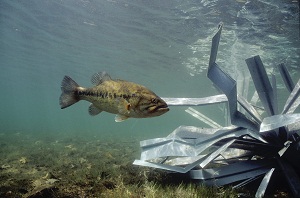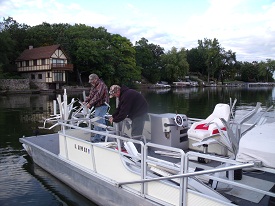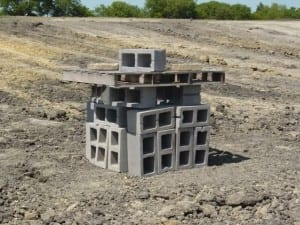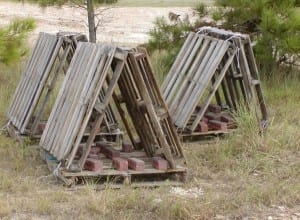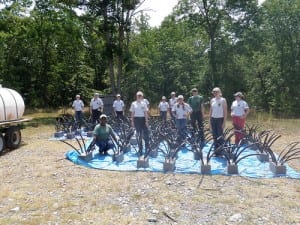
More than 800 million has been invested in recent years in these state fish habitat projects alone, see where your money is being spent…. See the dozens of unique artificial fish habitat models, fish attractors and fish cover used at fishiding.com, the industry leader and only science based, man made and artificial fish habitat, proven to provide all fish with cover they prefer to prosper. Below are examples of projects FishAmerica has funded in each state. For a complete list, contact FishAmerica, 703.519.9691*Indicates a project funded by the Research Projects Committee. A C D F G H I L M N O P R S T U V W CANADA
ALABAMA Alabama Division of Wildlife and Freshwater Fisheries (2004: $5,000) To restore fish habitat in Logan-Martin Lake through the placement of brush piles, cut trees, and new aquatic vegetation. Alabama Department of Conservation & Natural Resources (2004: $5,000) To purchase stocked catfish for the 2004 and 2005 Joe Wheeler Lake Youth Fishing Event at Wheeler Lake. ALASKA Youth Restoration Corps (2004: $10,000) To stabilize streambanks and restore fisheries habitat along an acre of the Caribou, Crescent, and Cooper Creeks in Chugach National Forest. Alaska Association of Conservation Districts (2004: $7,500) To stabilize and revegetate 4,500 square feet of Cottonwood Creek in the Cook Inlet watershed. ARIZONA *Anglers United (2000: $15,000) To conduct an economic impact study of an improved Lake Havasu fisheries resource. Anglers United (2000: $4,400) To purchase fish habitat materials for the final stages of the Lake Havasu Fisheries Improvement Program. ARKANSAS Arkansas Game and Fish Foundation and Arkansas Game and Fish Commission (2004: $5,000) To construct and place 20 PVC fish habitat shelters in Beaver Lake. Arkansas Game and Fish Commission (2002: $5,000) To restore sport fishing in Lake Ouachita. Top CALIFORNIA Aquatic Adventures Science Education Foundation (2004: $25,000) To restore and improve rearing and foraging habitat and water quality at the mouth of the San Diego River. Sonoma Ecology Center (2004: $49,380) To restore water quality and fisheries habitat for steelhead and chinook salmon in the San Francisco Bay watershed through riparian revegetation. COLORADO West Denver Chapter of Trout Unlimited (2003: $1,943) To repair and prevent further erosion damage around three fishing platforms and a dam at an educational center fishing pond. *Colorado Division of Wildlife (2001: $2,500) To pilot the Colorado fly-fishing Ladies, Let’s GO Fishing Seminar. CONNECTICUT Old Saybrook Land Trust (2004: $19,000) To construct a fishway to open 11 mile sand 15 acres of spawning habitat for anadromous fish in the Long Island Sound watershed. Save the Sound (2000: $17,364) To install an Alaskan steep pass fishway at the Main Street Dam on the Rippowam/Mill River. Top DELAWARE Delaware Center for the Inland Bays (2003: $1,237) To restore passage of American Eel through the construction of an eelway at Millsboro Pond dam. Delaware Department of Natural Resources (1991: $5,700) To provide channel catfish and fish attractor devices for restoration project on Silver Lake. DISTRICT OF COLUMBIA Sport Fishing Institute (1994: $15,000) To support the Sport Fishing Institute’s sport fishing research and conservation program. Sport Fishing Institute Artificial Reef Development Center (1991: $10,000) To develop a manual on artificial habitat improvement techniques to be used by FishAmerica grantees, civic groups, and sporting clubs. Top FLORIDA Wildlife Research Team (2004: $35,000) To restore fisheries habitat and reconnect tidal flow to 23 acres of mangrove forest in the Biscayne Bay watershed. St. Lucie County, Florida (2004: $50,000) To restore tidal flow and fish passage through the replacement of six culverts in the Indian River Lagoon. Top GEORGIA Lake Oconee Bass Masters & the Georgia Department of Natural Resources (2002: $10,000) To restore fisheries habitat and water quality in Lake Oconee by planting submerged aquatic vegetation and stabilizing the lake’s shorelines. Rome-Floyd Parks and Recreation Authority (1991: $7,600) Second year of funding for a bank stabilization project on the Coosa River. Top HAWAII Wahiawa Intermediate School (1998: $6,000) To construct a multiple use hatchery and rearing facility on the campus of Wahiawa Intermediate School to spawn and rear largemouth bass for stocking in Lake Wilson. Top IDAHO West Central Highlands Resource Conservation and Development Council, Inc. (2003: $32,000) To create a DNA library of genetic information for bull trout in order to provide insight into the geographic patterns of genetic diversity, degree of population isolation, and the gene flow patterns of bull trout. Henry’s Fork Foundation (2000: $6,000) To revegetate streambanks along the famed Henry’s Fork of the Snake River. ILLINOIS Hofmann Dam River Rats (2002: $5,000) To enhance instream habitat and stabilize the shoreline along the Des Plaines River. Illinois Conservation Foundation (2000: $4,000) To help construct an artificial reef in southern Lake Michigan near Chicago. INDIANA Southeastern Indiana Bass Stocking Association (1987: $1,650) To purchase equipment and supplies for rearing fingerling largemouth bass for stocking in embayments of the Ohio River. Camp Tecumseh, YMCA (1989: $6,000) To improve habitat for lake that serves Boy Scouts and campers. IOWA South Sioux City Community Foundation (2004: $7,500) To restore an fisheries habitat and an urban family fishing area in South Sioux City through streambank stabilization. Washington County Conservation Foundation (2003: $2,000) To build an interactive display for the new Washington County Conservation Education Center. Top KANSAS City of Overbrook (2001: $1,000) To purchase 2,000 largemouth bass fingerlings to stock new lake. Kansas Wildscape Foundation (2000: $1,250) To enhance fish habitat and improve water quality on a 15-acre pond by providing an alternative water source for cattle. KENTUCKY Kentucky Department of Fish and Wildlife Resources (2003: $5,000) To restore fisheries habitat by stabilizing 1,600 feet of shoreline on Kentucky Lake. Twin Lakes Crappie Club (2001: $4,000) To purchase artificial reef habitat material for an enhancement project on Kentucky and Barkley Lakes. Top LOUISIANA Louisiana Wildlife and Fisheries Foundation & Louisiana Department of Wildlife and Fisheries (2004: $5,000) To purchase and stock Phase II Florida strain largemouth bass in Atchafalaya Basin. New Orleans City Park Improvement Association (2002: $16,500) To improve fisheries habitat in the City Park Lagoon System by installing aerators and improving fish passage into the lagoon. Top MAINE *Maine Department of Inland Fisheries and Wildlife (2003: $15,660) To determine which of three strains of brook trout will improve survival rate and sportfishing in stocked fishing ponds. Kennebec County Soil & Water Conservation District (2002: $25,000) To improve fish passage, habitat and water quality in Dearborn Creek by replacing a culvert, removing debris from the streambed and stabilizing the streambanks. MARYLAND Severn River Association (2004: $30,000) To restore two acres of fish habitat in Hidden Pond in the Chesapeake Bay watershed. The Potomac Conservancy (2004: $16,422) To improve fisheries habitat and water quality through riparian revegetation in Carroll Creek within the Monocacy River watershed. MASSACHUSETTS Town of Dennis, Massachusetts (2004: $28,800) To restore anadromous fish habitat through the replacement of two culverts along Quivett Creek. Town of Truro, Massachusetts (2004: $17,500) To restore the fisheries habitat of a 717-acre lagoon and salt marsh system in the East Harbor Estuary. MICHIGAN Michigan Council of Trout Unlimited (2002: $8,300) To restore fisheries habitat in Michigan’s streams through dredging. Michigan Department of Natural Resources (2001: $5,000) To stock Pocket Pond, a kids’ fishing pond at the Michigan State Fairgrounds. MINNESOTA Minnesota Department of Natural Resources (2002: $5,000) To restore instream walleye habitat and improve water quality on the Cannon River by installing habitat structures and stabilizing streambanks. Outdoor Heritage Education Center (2001: $500) To purchase artificial habitat materials for Swan Lake. MISSISSIPPI Mississippi Department of Marine Resources (2004: $29,990) To improve water quality and fisheries habitat through the creation of two oyster reefs in Back Bay Biloxi and St. Louis Bay. Holly Springs National Forest (1997: $27,500) To add 40 gravel spawning beds, 30 brush pile fish attractors, and 250 underwater ledges, channels and islands to Chewalla Lake, a 260-acre recreational fishery which supports bass, bluegill, red ear, and channel catfish populations. MISSOURI Florissant-Ferguson School District (2000: $10,000) To construct a ½ acre public fishing pond in the school’s Little Creek Nature area. Mark Twain National Forest (1999: $4,000) To conduct habitat enhancement projects on Mill Creek, a popular bass and bluegill stream. MONTANA The Big Blackfoot Chapter of Trout Unlimited (2003: $20,000) To restore 11,000 feet of the lower Nevada Spring Creek to improve water quality and habitat quantity for westslope cutthroat and brown trout. Madison-Gallitin Chapter of Trout Unlimited (1998: $6,000) To restore prime spawning and rearing habitat for brown, rainbow, and cutthroat trout through placement of log cover, bank reconstruction, and planting of willows. Top NEBRASKA National Outdoorsmen’s Conservation Foundation (1984: $2,500) To improve habitat for private ponds open to the public. NEVADA Humboldt-Toiyabe National Forest (1997: $10,000) To remove a culvert blocking the upstream migration of the bull trout and redband trout. Las Vegas Flyfishing Club (1990: $840) To construct in-stream habitat structures in Beaver Dam Creek, a tributary of the Schroeder Reservoir. NEW HAMPSHIRE *New Hampshire Lakes Association (2002: $9,000) To determine the economic value of New Hampshire’s surface waters showing the importance to recreational fishing and boating. New Hampshire Department of Environmental Services (2002: $10,000) To restore fish passage on the Contoocook River by removing the West Henniker Dam. NEW JERSEY New Jersey Conservation Officers Association (2003: $6,650) To restore three ponds, totaling 25 acres, at Pinelands High School in Little Egg Harbor. Ocean County Planning Department (2001: $8,700) To restore 35 acres of salt marsh in the Barnegat Bay watershed by recreating the natural tidal flow in the marsh. NEW MEXICO New Mexico Trout (1998: $10,000) To purchase fencing and native riparian vegetation for a habitat restoration and hands-on environmental education project on the Santa Fe River. NEW YORK New York State Department of Environmental Conservation (2004: $50,000) To install a fishway to open up 29 miles of spawning and nursery habitat for American shad. Trout Unlimited-Art Flick Chapter (2003: $21,830) To install a fish ladder at Hard’s Lake Dam on the Carmans River to open more than 30 acres of spawning habitat and two miles of riverine habitat. NORTH CAROLINA North Carolina Coastal Federation (2004: $17,525) To improve water quality and fisheries habitat through the creation of oyster reefs and restoration of 6,000 acres of the North River. Coastal Conservation Association–North Carolina & the Long Bay Artificial Reef Association (2002: $10,000) To restore fisheries habitat along coastal North Carolina by creating artificial reefs. NORTH DAKOTA North Dakota Game and Fish Department (2003: $25,000) To remove silt, improve streambank rip rap, and improve a spillway structure at the Dickinson Dike on the Missouri River. Bowman-Slope Conservation District (1994: $5,000) To construct a water control structure and purchase rock rip rap to reduce sedimentation in the Bowman/Haley Reservoir. Top OHIO Muskingum Watershed Conservancy District (2000: $10,000) To purchase 180 Berkley Fish Habs to attract fish and create essential habitat cover at four public lakes. Lake Improvement Association (1993: $973) To construct fish attractors in Grand Lake St. Mary’s. OKLAHOMA Nichols Marine Vision for the Preservation of Fishing (2004: $5,000) To restore 9,000 feet of shoreline through the planting of water willow in Lake Eufaula. 89er Chapter of Trout Unlimited (2002: $8,000) To restore family fishing opportunities in Oklahoma City by installing an aerator in a local fishing pond. OREGON Coos Watershed Association (2004: $36,850) To restore instream habitat for salmon and trout in Andersen and Dalton Creeks in the Coos Bay watershed. *Ducks Unlimited, Inc. (2003: $25,350) To determine and describe the use of floodplain wetlands as over-wintering habitat by young-of-year and yearling coho and chinook salmon and to determine their ability to use water-control structures for passage in and out of wetlands. Top PENNSYLVANIA Southeastern Pennsylvania Resource Conservation and Development Council (2004: $22,000) To restore anadromous and freshwater fish access to one mile of upstream fisheries habitat in the Delaware River watershed. Izaak Walton League (2004: $20,000) To create riparian stream buffers, install livestock fencing and reconstruct natural stream channels along 25,000 linear miles of stream in Mill Creek. Top RHODE ISLAND Eastern Rhode Island Conservation District (2003: $7,000) To restore tidal flow and fish access to Potter’s Cove Pond by replacing damaged culverts. Town of Warren (2000: $25,000) To restore herring runs on the Kickemuit River by constructing a fish ladder at the Kickemuit Reservoir. Top SOUTH CAROLINA Coastal Conservation Association, South Carolina (2002: $7,100) To create and restore oyster beds as essential fish habitat in coastal South Carolina. South Carolina Department of Natural Resources (2001: $13,900) To create and restore oyster beds as essential fish habitat in coastal South Carolina. South Carolina Department of Natural Resources (2000: $5,000) To purchase materials to anchor and install Christmas trees in Lake Murray. SOUTH DAKOTA South Carolina Department of Natural Resources (2003: $13,210) To restore essential fish habitat through the construction/restoration of 30 oyster reefs along the South Carolina coast. Coastal Conservation Association–South Carolina (2002: $7,100) To create and restore oyster beds as essential fish habitat in coastal South Carolina. Top TENNESSEE Sumner County Convention and Visitors Bureau (2004: $5,000) To repair a currently existing boat ramp at Bull’s Creek in Old Hickory Lake. Tennessee Wildlife Resources Foundation (2002: $5,000) To convert a four-acre retention pond into a fish-rearing pond for state hatcheries in the Old Hickory Wildlife Management Area. TEXAS Friends of Aransas and Matagorda Island National Wildlife Refuge’s (2004: $12,500) To restore fish passage to the Brundrett Lakes through the replacement of two failing culverts. Galveston Bay Foundation (2000: $15,000) To restore salt marsh areas in the Galveston Bay area. Top UTAH State of Utah Division of Wildlife Resources (2003: $16,000) To improve sportfishing opportunities and install fish habitat structures at two fishing ponds Helper and Price cities. Helper City (1994: $5,275) To assist with habitat (stream channel) improvement to the Price River as part of a comprehensive fishery improvement program. Top VERMONT NorthWoods Stewardship Center (2004: $6,170) To revegetate nearly six acres of riparian habitat in the third and final phase of the Sleepers River Riparian Restoration Project. Otter Creek Natural Resources Conservation District (2003: $15,000) To restore instream habitat and improve water quality along 10 miles of stream in the Lake Champlain watershed. VIRGINIA Northumberland Association for Progressive Stewardship (2004: $3,800) To restore fisheries habitat and improve water quality by planting native vegetation on Yeocomico River shorelines. The Elizabeth River Project (2004: $25,000) To improve water quality and fisheries habitat through restoration of a one-third acre oyster reef at the mouth of Paradise Creek. Top WASHINGTON Willapa Bay Fisheries Enhancement Group (2004: $48,500) To restore fish passage for salmonids to more than 4.1 miles of upstream spawning habitat in the Willapa Bay watershed. Nooksack Salmon Enhancement Association (2004: $10,000) To restore fisheries habitat by stabilizing 2,500 feet of streambank in the Nooksack River watershed. WEST VIRGINIA Upper Knapps Creek Watershed Association (2001: $10,000) To restore instream habitat and stabilize streambanks along 17 miles in the Upper Knapps Creek watershed. Lower Paint Creek Association (2000: $8,000) To stabilize the stream banks and create plunge pools on Paint Creek. WISCONSIN Florence County Forestry & Recreation Department (2002: $3,000) To improve walleye populations in Florence County lakes by improving the county’s walleye rearing pond. Walleyes for Tomorrow (2000: $10,000) To create walleye spawning habitat in Green Bay. WYOMING Little Bighorn Chapter of Trout Unlimited (1995: $6,000) To stabilize eroding banks and to create additional plunge pools to increase habitat availability for cutthroat and brook trout on the Little Big Horn and South Tongue. Flaming Gorge/Lower Green River Chapter of Trout Unlimited (1995: $4,500) To purchase vegetation and conduct riparian stabilization projects on the “Big Bend Areas” of the Big Sandy River. Top CANADA *The University of British Columbia Fisheries Centre (2003: $20,000) To determine survival rates or marine mortality of juvenile Coho salmon in Howe Sound, British Columbia. Conservation Niagara Foundation (2003: $13,000) To improve habitat and public fishing opportunities at two of Niagara Peninsula’s popular public fishing areas. |  Friday, March 8, 2013 at 9:21AM ActivistAngler.com
Friday, March 8, 2013 at 9:21AM ActivistAngler.com
